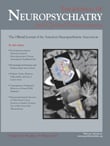A Case of Severe Toluene Withdrawal Syndrome Treated With Clonazepam
To the Editor: Inhalant abuse is a not uncommon substance abuse disorder that affects mainly adolescents and young adults. 1 Although withdrawal syndrome has been reported in up to 11% of inhalant abusers, the data on its clinical manifestations and treatment are still limited. 1 , 2 To the best of our knowledge, there has been no report on the use of clonazepam in the treatment of solvent withdrawal syndrome.
Case Report
We report the case of a 22-year-old man, a chronic toluene abuser since the age of 13, without any comorbid psychiatric disorder or history of other substance abuse. He received toluene holding a rag saturated in paint thinner to his face for many hours daily and all night long, while he was sleeping. During the last 2 years, he presented with parkinsonism and ataxia affecting his overall personal and social functioning, whereas abstinence resulted twice in withdrawal syndrome with anxiety, insomnia, irritability, and aggressive behavior, which lasted approximately 2 days and resolved after the resumption of toluene abuse. Toluene abuse was perforce discontinued when the patient was incarcerated for violent behavior against his brother. Three days later, he was admitted to our hospital with severe tremor, hypertonia, abasia, ataxia, cognitive impairment—disturbances of orientation, memory and concentration—anxiety, insomnia, and irritability. His scores on the Abnormal Involuntary Movement Scale (AIMS) and on the Mini-Mental State Examination (MMSE) were 29 and 12, respectively. The findings of the laboratory workup were normal with the exception of his MRI scan, which revealed mild cerebral and cerebellar atrophy as well as low signal in the basal ganglia. We prescribed clonazepam titrated to 2 mg/day. Within a week, the patient’s anxiety, insomnia, and irritability remitted completely, whereas his motor symptoms and cognitive functioning gradually improved. Two weeks later he could walk without support. His score on the AIMS dropped to 15, whereas his MMSE score increased to 25.
Discussion
This case report illustrates the severe symptoms after withdrawal from chronic heavy solvent abuse and the therapeutic difficulties due to the possible serious brain damage caused by toluene. MRI abnormalities in chronic toluene abuse and their clinical correlates have already been reported. 3 In our case, brain damage resulted in parkinsonism, ataxia, and mild cognitive impairment, whereas toluene withdrawal was followed by an exacerbation of these symptoms as well as anxiety, insomnia and irritability. The use of clonazepam was consequently indicated because of its anxiolytic, sedative, myorelaxant, and antiparkinsonian properties.
Chronic exposure to toluene may induce enhancement of NMDA glutamatergic neurotransmission coupled with reduced GABAergic activity. These alterations may result in increased behavioral activity during withdrawal from chronic toluene exposure. 4 Consequently, clonazepam, a high-potency benzodiazepine which acts as a GABA A receptor agonist—enhancing thus GABAergic neurotransmission—may ameliorate the withdrawal symptoms of chronic toluene abuse. Moreover, clonazepam may also inhibit NMDA glutamatergic activity through the functional interaction between glutamatergic and GABAergic systems. 5
Although anecdotal, the data of our case suggest that clonazepam might be efficacious as monotherapy in the treatment of toluene withdrawal syndrome.
1. Ridenour TA, Bray BC, Cottler LB: Reliability of use, abuse, and dependence of four types of inhalants in adolescents and young adults. Drug Alcohol Depend 2007; 91:40–49Google Scholar
2. Shah R, Vankar GK, Upadhyaya HP: Phenomenology of gasoline intoxication and withdrawal symptoms among adolescents in India: a case series. Am J Addict 1999; 8:254–257Google Scholar
3. Caldemeyer KS, Armstrong SW, George KK, et al: The spectrum of neuroimaging abnormalities in solvent abuse and their clinical correlation. J Neuroimaging 1996; 6:167–173Google Scholar
4. Bale AS, Tu Y, Carpenter-Hyland EP, et al: Alterations in glutamatergic and GABAergic activity in hippocampal neurons following exposure to the abused inhalant toluene. Neuroscience 2005; 130:197–206Google Scholar
5. Allison C, Pratt JA: Neuroadaptive processes in GABAergic and glutamatergic systems in benzodiazepine dependence. Pharmacol Ther 2003; 98:171–195Google Scholar



